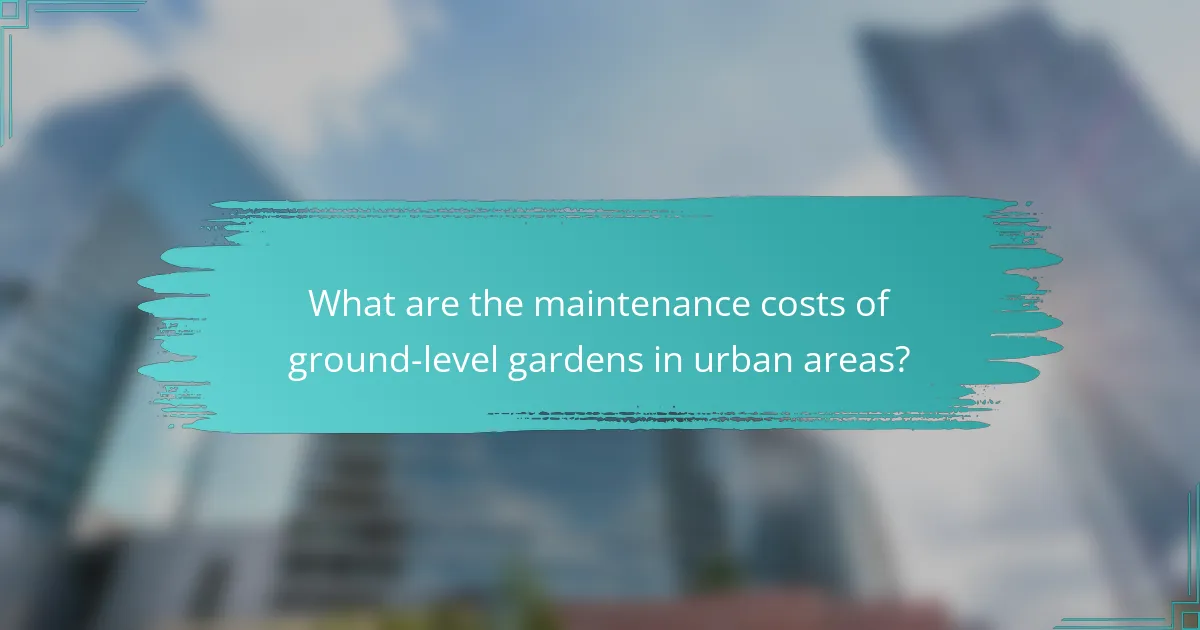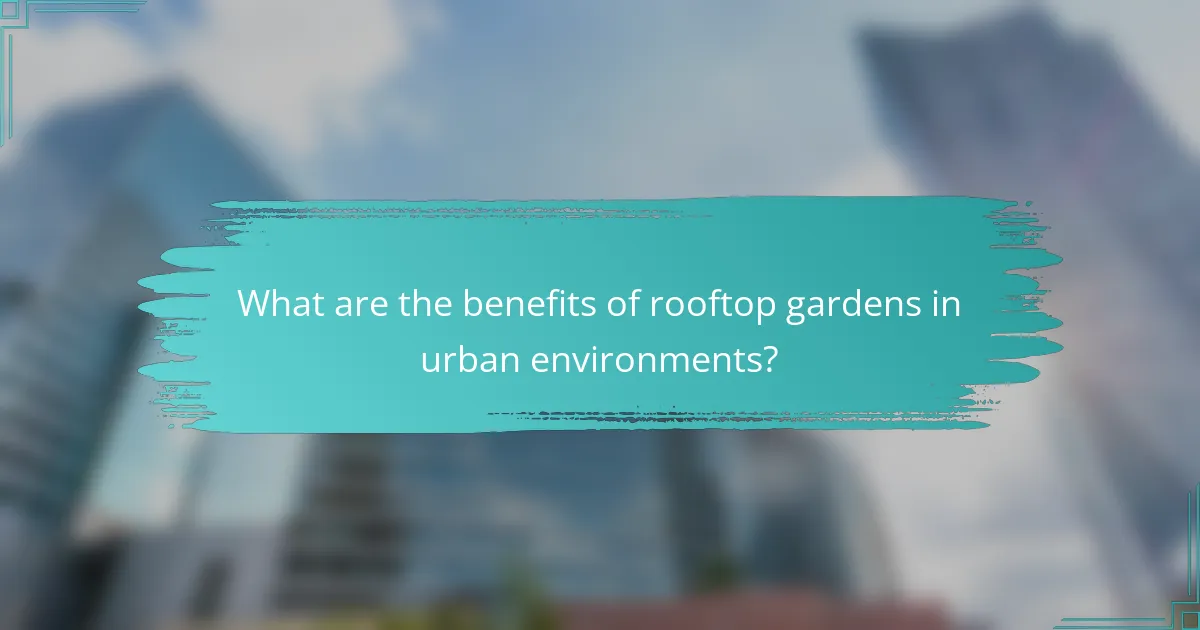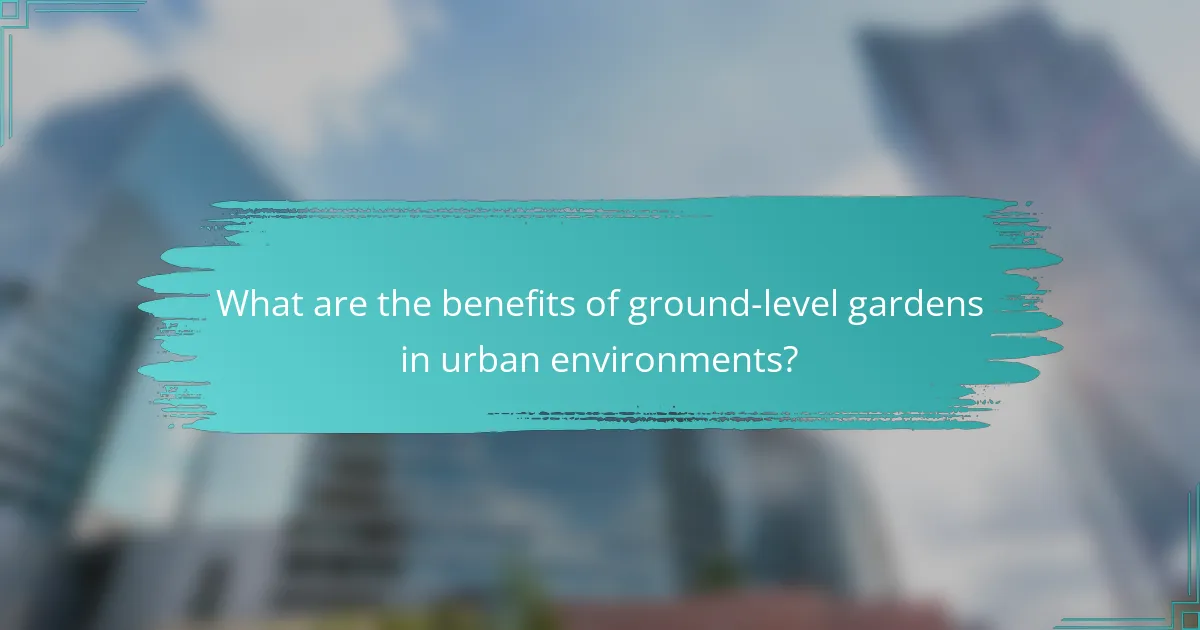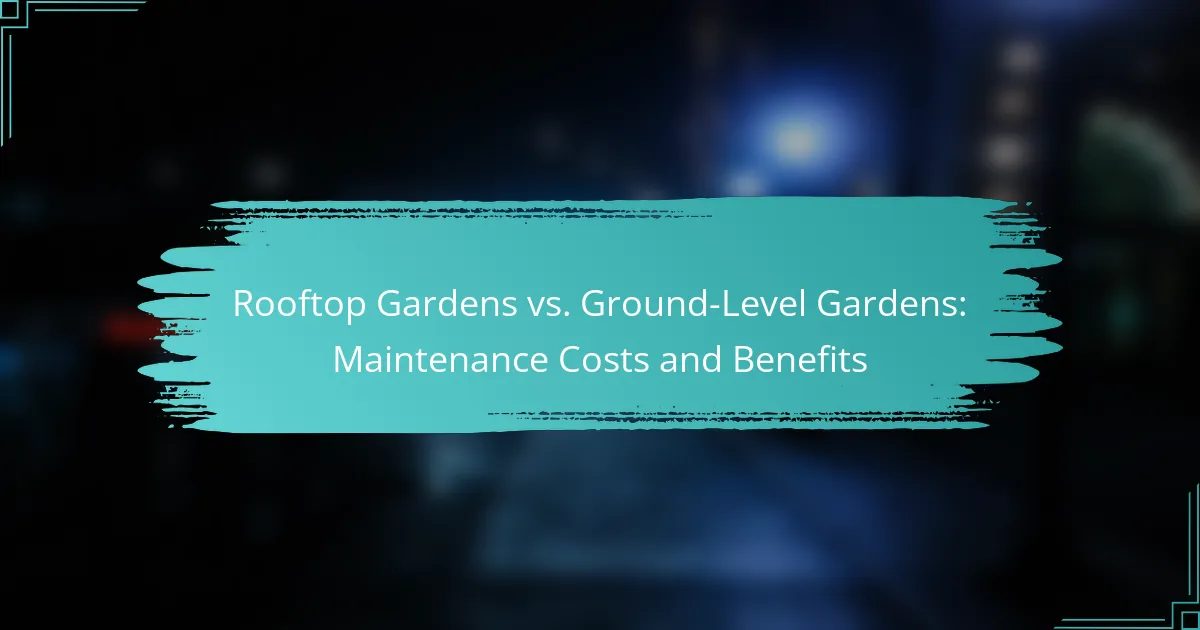Rooftop gardens and ground-level gardens each present unique maintenance costs and benefits that are crucial for urban dwellers to consider. While rooftop gardens can enhance property values and improve air quality, they often come with higher initial setup and ongoing upkeep expenses. In contrast, ground-level gardens may require less investment in structural modifications but still demand regular labor and resources to thrive. Understanding these factors can help in making informed decisions about urban gardening options.

What are the maintenance costs of rooftop gardens in urban areas?
Rooftop gardens in urban areas can incur significant maintenance costs, influenced by factors such as initial setup, ongoing upkeep, and specific environmental conditions. Understanding these costs is essential for effective budgeting and management.
Initial setup costs
The initial setup costs for rooftop gardens can vary widely, typically ranging from several thousand to tens of thousands of dollars. Factors influencing these costs include structural assessments, waterproofing, soil depth, and plant selection. Urban areas may require additional expenses for compliance with local building codes and regulations.
Ongoing maintenance expenses
Ongoing maintenance expenses for rooftop gardens generally include regular inspections, plant care, and seasonal adjustments. These costs can range from hundreds to a few thousand dollars annually, depending on the garden’s size and complexity. Regular maintenance is crucial to ensure plant health and prevent structural damage.
Water usage costs
Water usage costs for rooftop gardens can be significant, particularly in areas with high water rates. On average, a rooftop garden may require several hundred gallons of water per week during peak growing seasons. Implementing efficient irrigation systems can help mitigate these costs and conserve water.
Labor costs for upkeep
Labor costs for maintaining rooftop gardens can vary based on the level of expertise required and the frequency of maintenance tasks. Hiring professional landscapers or garden maintenance services can lead to expenses in the low hundreds to thousands of dollars per month. DIY maintenance can reduce costs but may require a time commitment and gardening knowledge.
Insurance considerations
Insurance considerations for rooftop gardens are essential, as they may impact overall maintenance costs. Property owners should consult with their insurance providers to understand coverage for potential damage, liability, and maintenance-related incidents. Additional premiums may apply, especially in urban areas where rooftop gardens are less common.

What are the maintenance costs of ground-level gardens in urban areas?
The maintenance costs of ground-level gardens in urban areas can vary significantly based on factors such as size, plant selection, and local climate. Generally, these gardens require ongoing investment in labor, materials, and utilities to remain healthy and visually appealing.
Initial setup costs
Initial setup costs for ground-level gardens typically include expenses for soil preparation, plants, seeds, and landscaping materials. Depending on the garden’s size and complexity, these costs can range from a few hundred to several thousand dollars. Urban areas may also require additional permits or fees for landscaping work, which can further increase initial expenses.
Ongoing maintenance expenses
Ongoing maintenance expenses for ground-level gardens encompass regular tasks such as weeding, fertilizing, and pest control. Homeowners can expect to spend anywhere from 50 to several hundred dollars monthly, depending on the garden’s size and the level of care required. Hiring professional landscapers can significantly raise these costs, but it may ensure better results.
Water usage costs
Water usage costs for ground-level gardens can vary based on local water rates and the garden’s irrigation needs. In urban settings, water bills may increase during dry seasons, with costs potentially reaching tens of dollars per month. Implementing efficient irrigation systems, such as drip irrigation, can help reduce water consumption and lower expenses.
Labor costs for upkeep
Labor costs for maintaining ground-level gardens can be a significant factor, especially if professional help is employed. Hiring a gardener or landscaping service can cost anywhere from 20 to 50 USD per hour, depending on the region and services provided. For DIY enthusiasts, investing time in learning proper gardening techniques can minimize these costs.
Insurance considerations
Insurance considerations for ground-level gardens include liability coverage for potential accidents or injuries occurring on the property. Homeowners should check their existing homeowner’s insurance policy to ensure it covers gardening activities. Additional coverage may be necessary if the garden includes features like water elements or heavy structures, which could increase risk.

What are the benefits of rooftop gardens in urban environments?
Rooftop gardens offer numerous advantages in urban settings, including improved air quality, increased property values, and effective stormwater management. These gardens not only enhance the aesthetic appeal of buildings but also contribute to environmental sustainability.
Improved air quality
Rooftop gardens help improve air quality by filtering pollutants and absorbing carbon dioxide. Plants naturally take in harmful gases and release oxygen, which can lead to a healthier urban atmosphere.
In densely populated areas, the presence of greenery can significantly reduce airborne particulate matter, benefiting residents’ respiratory health. Incorporating a variety of plants can maximize these air purification effects.
Increased property value
Investing in a rooftop garden can increase a property’s market value by enhancing its appeal and functionality. Properties with green spaces are often more attractive to potential buyers and tenants, leading to higher rental and sale prices.
Studies indicate that homes with well-maintained gardens can see value increases ranging from 10% to 20%. This makes rooftop gardens not only an aesthetic choice but also a smart financial investment.
Stormwater management
Rooftop gardens play a crucial role in managing stormwater by absorbing rainwater and reducing runoff. This helps prevent flooding and minimizes the burden on urban drainage systems during heavy rainfall.
By retaining water, these gardens can also help filter pollutants before they reach the water supply. Implementing a green roof can reduce stormwater runoff by up to 50%, depending on the design and plant selection.
Urban heat island effect reduction
Rooftop gardens contribute to mitigating the urban heat island effect, where urban areas experience higher temperatures than their rural surroundings. The vegetation on rooftops provides shade and cools the air through evapotranspiration.
This cooling effect can lower indoor temperatures, reducing the need for air conditioning and leading to energy savings. In cities, green roofs can lower surface temperatures by several degrees, improving overall comfort for residents.
Enhanced biodiversity
Rooftop gardens can significantly enhance urban biodiversity by providing habitats for various species, including birds, insects, and other wildlife. These green spaces create essential ecosystems in otherwise concrete-dominated environments.
By selecting native plants, rooftop gardens can attract pollinators and support local wildlife, contributing to ecological balance. This biodiversity not only enriches the urban landscape but also promotes environmental resilience.

What are the benefits of ground-level gardens in urban environments?
Ground-level gardens offer numerous advantages in urban settings, including enhanced biodiversity, improved air quality, and increased community engagement. They provide accessible green spaces that can be enjoyed by residents, contributing to overall well-being and environmental sustainability.
Cost-effectiveness of ground-level gardens
Ground-level gardens typically have lower initial setup and ongoing maintenance costs compared to rooftop gardens. They require less structural reinforcement and can utilize existing soil, reducing the need for expensive materials. Additionally, maintenance tasks like watering and weeding are often easier and less costly.
Accessibility and community engagement
Ground-level gardens are generally more accessible for all community members, including those with mobility challenges. This inclusivity fosters community engagement, as residents can easily participate in gardening activities, workshops, or simply enjoy the space. Such interactions can strengthen neighborhood ties and promote local stewardship.
Environmental benefits
Ground-level gardens contribute significantly to urban biodiversity by providing habitats for various species, including pollinators. They help mitigate urban heat effects and improve air quality by absorbing carbon dioxide and releasing oxygen. Furthermore, these gardens can manage stormwater runoff effectively, reducing the risk of flooding in urban areas.
